To ensure the health and moisture of your hair in a protective style, moisturize it every 2-3 days. Caring for your hair in a protective style is essential to maintain its health and vitality.
Whether you opt for braids, twists, or a weave, ensuring that your locks remain moisturized is crucial.
Moisturizing your hair regularly helps prevent dryness, breakage, and other common issues. But how often should you moisturize your hair in a protective style?
We will discuss the ideal frequency to keep your hair hydrated and thriving. By following these guidelines, you can maintain strong, healthy hair while rocking your favorite protective styles. So, let’s dive in and discover the best approach to moisturizing your hair in a protective style.
Benefits Of Moisturizing Your Hair In A Protective Style
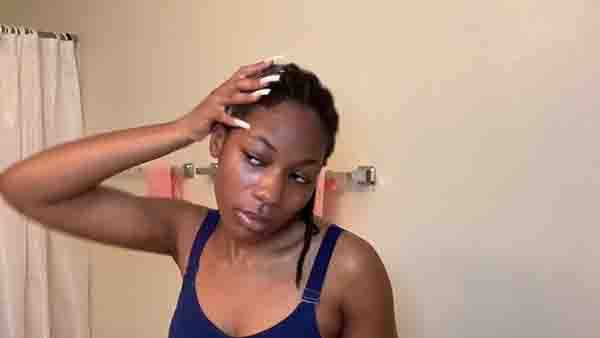
Moisturizing your hair in a protective style is essential for maintaining healthy and beautiful hair. We explore the various benefits of moisturizing in protective styles, emphasizing the importance of retaining moisture for hair growth and overall health.
1. Prevents Breakage
One of the primary benefits of moisturizing your hair in a protective style is breakage prevention. Dry hair is more susceptible to breakage and damage.
Protective styles, such as braids, twists, or weaves, can sometimes lead to moisture loss due to reduced exposure to external elements.
Regularly moisturizing your hair helps combat this issue, keeping it flexible and less prone to breakage.
2. Promotes Hair Growth
Moisturizing your hair while it’s in a protective style promotes hair growth by creating a conducive environment for your hair follicles. When your scalp and hair are adequately moisturized, it encourages healthy hair growth.
Dryness, on the other hand, can lead to a stagnant growth phase and increased hair shedding.
3. Maintains Moisture Balance
Maintaining a proper moisture balance is crucial for hair health. In protective styles, moisture loss can occur gradually, leading to brittle and weak hair.
By consistently moisturizing your hair, you can replenish lost moisture and maintain an optimal balance, ensuring that your hair remains strong and resilient.
4. Nourishes Hair Follicles
Moisturizing your hair also provides essential nutrients to your hair follicles. Proper nourishment helps in the production of healthy, strong hair strands.
Neglecting moisture can cause your hair follicles to become deprived of nutrients, hindering their ability to support hair growth.
5. Creates a Healthy Scalp Environment
A healthy scalp is crucial for overall hair health. Moisturizing your hair in a protective style contributes to a healthier scalp environment. Dryness and scalp issues can lead to hair problems, including dandruff and itchiness.
Adequate moisture can alleviate these issues, ensuring your scalp remains comfortable and free from irritations.
6. Enhances Hair Appearance
Moisturized hair in protective styles tends to look better and more vibrant. It has a natural sheen and is less prone to frizz and dullness.
Regular moisturizing can contribute to a more polished and attractive hairstyle.
How Do You Moisturize Protective Hair Styles
Here’s a simplified guide on how to moisturize your protective hairstyle:
1. Choose the Right Moisturizer
Opt for a moisturizing product suitable for your hair type and the specific protective style you’re wearing. Look for products that contain natural oils, shea butter, or other hydrating ingredients.
2. Daily or As Needed
Apply the moisturizing oil or cream directly to the roots and ends of your hair daily or as needed. Pay extra attention to any exposed sections or parts of your style.
3. Focus on the Ends
The ends of your hair are often the driest and most prone to damage. Ensure that they receive sufficient moisture to prevent split ends and breakage.
4. Avoid Overloading
While moisture is essential, avoid overloading your hair with product, as this can lead to buildup and a heavy feeling.
5. Gently Apply
Be gentle when applying the moisturizer to avoid frizz or disruption of your protective style, especially if you have braids or twists.
6. Protect Your Hair at Night
Before bedtime, use a satin or silk scarf or pillowcase to protect your hair. This helps prevent friction and retains moisture.
7. Avoid Excessive Manipulation
Minimize handling and manipulation of your protective style. Frequent touching or restyling can lead to frizz and disrupt your style.
8. Stay Hydrated
Hydrate your body by drinking enough water. Proper hydration from within can also contribute to the health and moisture balance of your hair.
10. Protect Your Edges
Pay special attention to the delicate hair around your edges. Gently apply moisturizer to this area to prevent dryness and breakage.
Hair Type And Texture
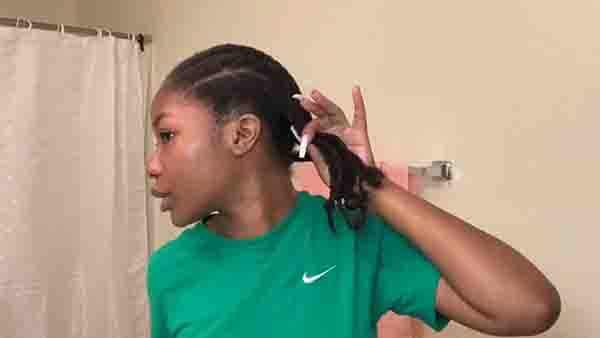
Understanding your hair type is a critical step in determining the frequency and method of moisturizing your hair while it’s in a protective style.
Different hair types have distinct needs, and tailoring your hair care routine accordingly is essential for maintaining healthy and hydrated hair.
In this section, we will discuss the significance of identifying your hair type and how it impacts your moisturization routine.
1. Know Your Hair Type
Before delving into a moisturization routine, it’s essential to accurately identify your hair type. Hair types are commonly categorized into straight, wavy, curly, and coily.
Additionally, you may hear terms like “fine,” “medium,” or “thick” to describe the diameter of individual hair strands. Knowing your hair type allows you to select products and techniques that cater to your specific needs.
2. Tailor Your Products
Once you’ve determined your hair type, you can choose the right products tailored to your hair’s unique characteristics. Different hair types require different formulations to achieve optimal moisturization. For example:
- Straight Hair: Straight hair tends to be naturally oily at the roots and may require lighter moisturizing products that won’t weigh it down.
- Wavy Hair: Wavy hair often benefits from products that provide both moisture and definition to enhance the natural wave pattern.
- Curly Hair: Curly hair typically craves more moisture due to its tendency to be drier. Products with extra hydration and curl-enhancing properties work well for this hair type.
- Coily Hair: Coily hair, with its tight curls and coils, needs rich, deeply penetrating moisturizers to combat dryness and maintain elasticity.
3. Frequency of Moisturization
The frequency of moisturization can also vary depending on your hair type. For example:
- Straight Hair: Straight hair may not require daily moisturization and can benefit from every few days to weekly treatments.
- Wavy Hair: Wavy hair may do well with regular moisturization every few days or as needed.
- Curly Hair: Curly hair often benefits from more frequent moisturization, ranging from daily to every other day.
- Coily Hair: Coily hair typically requires daily or near-daily moisturization to combat dryness effectively.
4. Protective Style Considerations
When your hair is in a protective style, such as braids, weaves, or twists, it’s crucial to adjust your moisturization routine accordingly.
Protective styles can limit direct access to your hair, making it challenging to apply products directly to your scalp and strands.
Using lightweight leave-in sprays or oils that can penetrate your protective style can help maintain moisture without disturbing the style.
Climate And Weather Conditions
The climate and weather conditions play a significant role in the health and appearance of your hair. Adjusting your moisturizing routine based on the weather can help you combat the effects of different climates and maintain optimal hair health.
1. Hot and Dry Weather
In hot and dry weather, the air tends to be low in humidity, which can lead to excessive moisture loss from your hair. To combat dryness and breakage:
- Increase Moisturization: In these conditions, you may need to moisturize your hair more frequently. Consider using hydrating leave-in conditioners, hair oils, or moisturizing sprays to replenish lost moisture.
- Protective Styling: Protective styles like braids or twists can help shield your hair from the harsh sun and prevent excessive moisture loss.
- Use Sun Protection: Just as you protect your skin from the sun, consider using hair products with UV protection to shield your hair from sun damage.
2. Cold and Humid Weather
Cold and humid weather can present its own set of challenges, such as frizz and product buildup. To maintain your hair’s health and appearance in these conditions:
- Moisturize Strategically: In humid weather, you may need to adjust the type of moisturizers you use. Lighter, water-based products can help prevent excessive moisture absorption and frizz.
- Anti-Frizz Products: Incorporate anti-frizz serums or creams into your routine to combat frizz caused by humidity.
- Clarifying Shampoo: Use a clarifying shampoo occasionally to remove product buildup, which can be more common in humid conditions.
3. Regular Assessment
Regardless of the weather conditions, it’s essential to regularly assess how your hair looks and feels. Pay attention to any changes and adjust your moisturizing routine accordingly. Factors such as the length of time your hair is in a protective style, its exposure to the elements, and your individual hair type all play a role in determining your specific needs.
4. Experiment and Find Balance
Experiment with different moisturizers and techniques to find the right balance for your hair type and the current weather conditions. You may need to fine-tune your routine as the weather changes throughout the year.
Duration Of The Protective Style
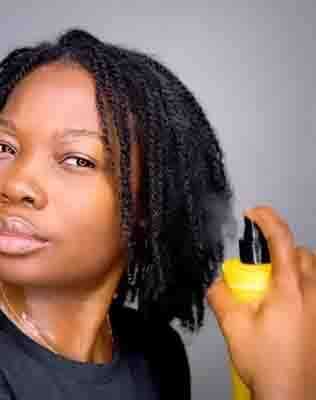
Maintaining proper moisture levels in your hair is essential, especially during long-term protective styles. The duration of your protective style significantly influences how often you should moisturize your hair.
1. Short-Term Protective Styles (a few days to a week)
- For protective styles that you plan to keep in for a few days to a week, applying a moisturizing spray every other day is generally sufficient to keep your hair hydrated.
- Use lightweight, water-based moisturizers or leave-in conditioners for shorter styles to prevent product buildup and maintain a comfortable feel.
2. Long-Term Protective Styles (several weeks to months)
- For longer-term protective styles that may stay in for several weeks or even months, a more consistent moisturizing routine is required.
- Aim to moisturize your hair every two to three days to prevent excessive dryness and brittleness. Deep conditioning treatments can also be beneficial in these cases.
- Consider using heavier, deeply hydrating products, such as hair creams or oils, to maintain moisture over an extended period.
3. Regular Assessment and Adaptation
- Regardless of the duration of your protective style, it’s crucial to pay attention to your hair’s needs and adjust your moisturizing frequency accordingly.
- Factors like your hair type, the climate, and the specific style you’re wearing can influence how quickly your hair loses moisture.
- Regularly assess your hair’s look and feel, and be prepared to make changes to your routine as needed to keep your hair well-nourished.
Daily Moisturizing Routine
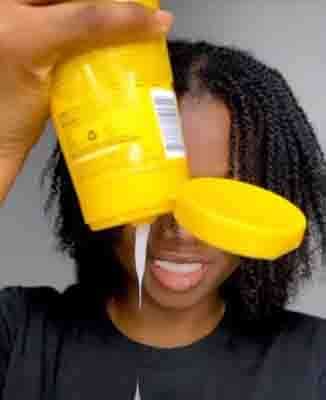
Daily moisturizing is a fundamental practice for maintaining the health and vitality of your hair, particularly when it’s in a protective style.
1. Consistency Is Key
Daily moisturizing is essential for preventing your hair from becoming dry and brittle. Consistency in your routine is crucial to keep your hair in its best condition.
2. Choosing the Right Products
Select products specifically designed for daily use in protective styles. Leave-in conditioners and moisturizing sprays are excellent choices as they are lightweight and won’t disrupt your style.
Ensure that the products you choose are free from harmful ingredients that could lead to product buildup or scalp irritation.
3. Focus on the Ends
Pay extra attention to the ends of your hair when applying moisturizer. The ends are typically the driest part of your hair and are more susceptible to breakage.
4. Scalp Massage
Incorporate a gentle scalp massage when applying moisturizer. Massaging your scalp not only helps distribute the product but also promotes blood circulation, which can stimulate hair growth.
5. Protecting Your Style
Be mindful of how you apply the moisturizer to avoid disturbing your protective style. Use a light touch to prevent frizz or unraveling.
Weekly Moisturizing Routine
1. Weekly Hydration
A weekly moisturizing routine is essential to combat dryness and breakage during protective styling. It ensures that your hair remains adequately hydrated throughout the week.
2. Product Selection
Choose products specifically formulated for your hair type and the particular protective style you’re wearing. Tailoring your products to your hair’s unique needs enhances their effectiveness.
Look for moisturizers containing nourishing ingredients like natural oils, shea butter, or aloe vera. These ingredients can help lock in moisture and maintain hair softness.
3. Even Application
Apply the moisturizer evenly throughout your hair, paying special attention to the ends. The ends are more susceptible to dryness and breakage and need extra care to retain moisture.
Gently work the product into your hair, being careful not to disrupt the protective style.
4. Preventing Dryness and Breakage
Consistent weekly moisturization prevents your hair from becoming excessively dry and brittle, reducing the risk of breakage, split ends, and other forms of damage.
5. Adapt to Your Needs
Be flexible with your moisturizing routine. Factors such as your hair type, climate, and the specific protective style you’re wearing can influence your hair’s moisture needs.
6. Consistency Matters
Consistency is key to effective moisturizing. Make your weekly routine a habit to ensure your hair looks and feels its best at all times.
Deep Conditioning And Hydration Treatments
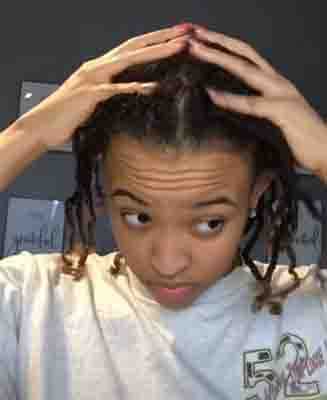
1. Deep Conditioning Treatment (Once a Week)
A deep conditioning treatment is a crucial part of your protective style routine. It provides your hair with intensive nourishment and helps repair any damage that may occur during styling or daily wear.
Aim to incorporate a deep conditioning treatment once a week to restore and maintain your hair’s health. Deep conditioners are formulated to penetrate the hair shaft deeply and provide essential nutrients.
Use a deep conditioner that aligns with your hair type and any specific concerns you may have, such as dryness, frizz, or damage.
2. Hydration Treatments (Every Two to Three Days)
In addition to deep conditioning, regular hydration treatments are essential for preventing dryness and maintaining moisture in your hair.
Include hydration treatments every two to three days to ensure your hair stays adequately moisturized. These treatments may involve using leave-in conditioners, moisturizing sprays, or oils designed for your hair type and protective style.
Hydration treatments help keep your hair soft, supple, and less prone to breakage. They also contribute to the overall health and appearance of your hair.
3. Benefits of Consistency
Consistency in deep conditioning and hydration treatments ensures that your hair receives a steady supply of nutrients and moisture, promoting its strength, shine, and resilience.
Over time, these treatments can repair and improve the condition of your hair, making it more manageable and vibrant.
Loc Method
1. The LOC Method Explained
The LOC method is a three-step process designed to maximize moisture retention in your hair. The acronym “LOC” stands for Liquid, Oil, and Cream.
2. Liquid (L)
The first step involves applying a liquid, which can be water or a leave-in conditioner, to your hair. This step helps hydrate and prepare your hair for the subsequent products.
3. Oil (O)
The second step is to seal in the moisture with an oil. Common choices include coconut oil, olive oil, or any preferred hair oil. The oil forms a barrier that prevents moisture from escaping, keeping your hair hydrated.
4. Cream (C)
The final step is to apply a cream or butter-based product. This product further locks in the moisture, providing an additional layer of protection and ensuring that your hair remains moisturized for an extended period.
Benefits of the LOC Method
- The LOC method is highly effective at preventing dryness and breakage in protective styles. It provides long-lasting moisture, making it particularly suitable for styles that are worn for an extended duration.
- By sealing in moisture and creating a barrier, the LOC method helps maintain your hair’s health and elasticity, allowing it to thrive in a protective style.
Frequency of Application:
It is recommended to follow the LOC method every few days, depending on your hair’s needs and the specific protective style you’re wearing. Regularly assess your hair to determine how often you should apply the LOC method to maintain optimal moisture levels.
Understanding Product Labels
Understanding product labels for haircare products used in protective styles is essential to ensure you choose the right products for your specific needs. Here’s a breakdown of key elements you might encounter on product labels for protective styles:
- Product Name and Brand: This section displays the product’s name and the company or brand that manufactures it.
- Ingredients List: Ingredients are listed in descending order of concentration. For protective styles, look for products that contain ingredients beneficial for hair health, such as moisturizers (e.g., glycerin, aloe vera), natural oils (e.g., coconut oil, argan oil), and strengthening agents (e.g., keratin, biotin).
- Usage Instructions: These instructions guide you on how to use the product effectively for your protective style. For example, it may recommend applying to damp or dry hair, focusing on the roots, or using a specific application technique.
- Directions for Application: Specific details on how to apply or use the product for protective styles may be provided. For example, if you’re using the product for braids, twists, or weaves, it may suggest applying directly to the scalp or along the length of the extensions.
- Purpose or Claims: Manufacturers may include statements about what the product is designed to do for protective styles, such as “moisturizing,” “strengthening,” “shine-enhancing,” or “frizz control.”
- Net Weight or Volume: This section tells you how much of the product is inside the packaging, usually measured in ounces (oz), milliliters (ml), or grams (g). Knowing the product’s size helps you determine how long it will last.
- Expiration Date or Period After Opening (PAO): Understanding the product’s shelf life is crucial, especially if you plan to use it over an extended period while in your protective style.
- Batch or Lot Number: This number can be essential for tracking the production batch in case of issues or recalls related to the product.
- Safety Precautions: Look for warnings and precautions related to the use of the product for protective styles. These may include avoiding contact with eyes, keeping out of reach of children, or using only as directed.
- Storage Instructions: Proper storage conditions, such as keeping the product in a cool, dry place or away from direct sunlight, can impact its shelf life and effectiveness.
- Recycling or Disposal Instructions: Information on how to recycle or properly dispose of the product and its packaging can be found on labels, promoting environmentally responsible use.
- Hypoallergenic: Some products may claim to be hypoallergenic, implying they are less likely to cause allergies or sensitivities, but be aware that this may not guarantee allergy-free results.
- Paraben-Free, Sulfate-Free, etc.: Look for specific claims related to ingredient exclusions, such as “paraben-free” or “sulfate-free,” if you have preferences regarding these ingredients.
- Hair Type Compatibility: Certain products may be labeled as suitable for specific hair types (e.g., curly, coily, straight) or ethnicities. Choosing products aligned with your hair type can enhance their effectiveness.
FAQ
Yes, allowing your hair to dry in braids can help maintain the braid pattern, but ensure your hair is fully dry to prevent mildew.
Sleeping in dry braids is better to prevent breakage and tangling, but ensure your hair is sufficiently dry.
Apply a lightweight oil or leave-in conditioner to your braids regularly to keep them moisturized and prevent drying.
Moisturized hair feels soft, smooth, and not excessively dry or brittle to the touch.
Drying time varies based on hair thickness and braid size, but it may take several hours to a day.
Use a water-based leave-in conditioner or oil to keep your hair hydrated while in knotless braids.
You can shower daily with braids, but avoid excessive wetting of the braids to maintain their longevity.
Spritz your hair with a water and leave-in conditioner mixture regularly and seal in moisture with a light oil.
Use a leave-in conditioner and oil to moisturize your hair in a protective style, focusing on the ends and scalp.
A few hair strands may break during oiling, which is normal hair shedding. However, excessive breakage may indicate an issue.
Maintain a protective style by keeping it clean, moisturized, and avoiding excessive manipulation.
Ensure your hair and scalp are clean, moisturized, and not under excessive tension in protective styles to promote hair health.
Spritz your hair with a water and leave-in conditioner mix, or use a lightweight hair oil to keep your natural hair moisturized.
Losing some hair after removing a protective style is normal, but excessive hair loss may indicate improper care or tension during styling.
Maintain protective hairstyles by keeping them clean, moisturized, and ensuring they aren’t too tight, which can lead to damage.
Yes, giving your hair a break between braided styles allows it to recover and prevents excessive stress on your scalp and hair.
Protective styles should not damage locs if done correctly; however, improper installation or excessive tension can lead to damage.
Conclusion
Maintaining the moisture balance of your hair while in a protective style is crucial for its overall health and vitality. By understanding the needs of your hair type and texture, you can determine how often to moisturize. Generally, it is recommended to moisturize your hair every two to three days, or as needed.
This will prevent dryness, breakage, and promote hair growth. However, it is important to note that each individual’s hair is unique, and what works for one person may not work for another. Listen to your hair, pay attention to its signals, and adjust your routine accordingly.
Additionally, incorporating a lightweight, water-based moisturizer and sealing in the moisture with natural oils or butters will aid in retaining hydration. Remember, keeping your hair moisturized while in a protective style will help you achieve and maintain healthy, luscious locks.

